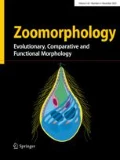Summary
The ocelli of trochophore and segmented larvae of the archiannelid Polygordius cf. appendiculatus were studied by electron microscopy. An eye consists of two pigmented supportive cells forming an eyecup that encloses one sensory cell bearing one (trochophore) or two (segmented larva) ranks of microvilli and one adventitious cilium. Remarkably abundant tubules (submicrovillar endoplasmic reticulum) radiate from the perinuclear region of the sensory cell, which lies outside the ocellus, toward its receptoral end. Possible functions of the tubules are proposed: carriers of ions, metabolites and photopigments; pinocytic uptake of products resulting from photoreception; storage of membrane; and light guides. Finally, the eyes of Polygordius larvae are believed to have evolutionary significance and provide further support for Eakin's theory of diphyletic origin of photoreceptors.
Similar content being viewed by others
References
Blest AD, Day WA (1978) The rhabdomere organization of some nocturnal Pisaurid spiders in light and darkness. Phil Trans R Soc London, Ser B 283:1–23
Brandenburger JL, Eakin RM (1980) Cytochemical localization of acid phosphatase in ocelli of the seastar Patiria miniata during recycling of photoreceptoral membranes. J Exp Zool 214:127–140
Eakin RM (1979) Evolutionary significance of photoreceptors: In retrospect. Am Zool 19:647–653
Eakin RM, Brandenburger JL (1970) Osmic staining of amphibian and gastropod photoreceptors. J Ultrastruct Res 30:619–641
Eakin RM, Brandenburger JL (1978) Autofluorescence in the retina of a snail, Helix aspersa. Vision Res 18:1541–1543
Eakin RM, Brandenburger JL (1980) Studies on calcium in the eye of the snail Helix aspersa. Proc Annu Meet Electron Micros Soc Am, pp 566–567
Eakin RM, Brandenburger JL, Mortensen C, King D (1974) Evidence for photosensory role of vesicles in the retina of a pulmonate snail. Electron Microsc Proc Int Congr Canberra Vol II pp 370–371
Eakin RM, Martin GG, Reed CT (1977) Evolutionary significance of fine structure of archiannelid eyes. Zoomorphologie 88:1–18
Eakin RM, Westfall JA (1964) Further observations on the fine structure of some invertebrate eyes. Z Zellforsch Mikrosk Anat 62:310–332
Eisenman EA, Das NK, Alfert M (1977) Concanavalin A induced changes in the submembranous contractile structure in fertilized eggs of Urechis caupo. J Cell Biol 75:264a
Fischer A, Brökelmann J (1966) Das Auge von Platynereis dumerilii (Polychaeta) sein Feinbau im ontogenetischen und adaptiven Wandel. Z Zellforsch Mikrosk Anat 71:217–244
Fraipont J (1887) Le Genre Polygordius. Fauna und Flora des Golfes von Neapel. Zoologischen Station zu Neapel 14:1–125
Hara T, Hara R (1972) Cephalopod Retinochrome. In: Dartnall HJA (ed) Handbook of Sensory Physiology, Vol VII, part 1. Springer, Berlin Heidelberg New York, pp 720–746
Hatschek B (1881) Protodrilus leuckartii. Eine neue Gattung der Archianneliden. Arb Zool Inst Univ Wien 3:79–92
Hermans CO (1969) The systematic position of the Archiannelida. Syst Zool 18:85–102
Hermans CO, Cloney RA (1966) Fine structure of the prostomial eyes of Armandia brevis (Polychaeta: Opheliidae). Z Zellforsch Mikrosk Anat 72:583–596
Holborow PL, Laverack MS (1972) Presumptive photoreceptor structures of the trochophore of Harmothoë imbricata (Polychaeta). Mar Behav Physiol 1:139–156
Itaya SK (1976) Rhabdom changes in the shrimp, Palaemonetes. Cell Tissue Res 166:265–273
Salvini-Plawen Lv, Mayr E (1977) On the evolution of photoreceptors and eyes. In: Hecht MK, Steere WC, Wallace B (eds) Evolutionary Biology, Vol. X. Plenum Publ Corp, New York, pp 207–263
Sperling L, Hubbard R (1975) Squid retinochrome. J Gen Physiol 65:235–251
Stowe S (1980) Rapid synthesis of photoreceptor membrane and assembly of new microvilli in a crab at dusk. Cell Tissue Res 211:419–440
Vanfleteren JR, Coomans A (1976) Photoreceptor evolution and phyologeny. Z Zool Syst Evolutionsforsch 14:157–169
Whittle AC (1976) Reticular specilizations in photoreceptors: a review. Zool Scr 5:191–206
Woltereck R (1902) Trochophora-Studien I. Über die Histologie der Larve und die Entstehung des Annelids bei den Polygordius-Arten der Nordsee. Zoologica. Original-Abhandlungen dem Gesammtgebiete der Zoologie 13(34):1–71
Author information
Authors and Affiliations
Rights and permissions
About this article
Cite this article
Brandenburger, J.L., Eakin, R.M. Fine structure of ocelli in larvae of an archiannelid, Polygordius cf. appendiculatus . Zoomorphology 99, 23–36 (1981). https://doi.org/10.1007/BF00310352
Received:
Issue Date:
DOI: https://doi.org/10.1007/BF00310352




